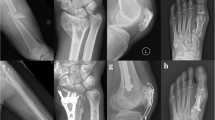Summary
The foramen ovale is anatomically open in 25 % of individuals, but functionally closed by the higher pressure in the left antrum. Right-to-left shunt and subsequent paradoxical embolism may occur when pressure in the left antrum rises, for example, as a result of pulmonary embolism. In the present case we demonstrate a patient who presented 20 days after osteosynthetic treatment of a femoral fracture with word-finding deficits. Cerebral MRT revealed a fresh ischemic insult. Duplex ultrasound of the legs showed a fresh thrombosis of the superficial femoral vein and scintigraphy of the lungs detected pulmonary embolism. Transesophageal contrast echocardiography trapped a hemodynamically spontaneous, open foramen ovale. Duplex ultrasound of the carotid arteries detected no pathological findings. Deep vein thrombosis and pulmonary embolism can be clinically unconspicuous and become manifest by cerebral deficits resulting from paradox embolism and cerebral ischemia.
Zusammenfassung
In etwa 25 % der Fälle ist im Erwachsenenalter das Foramen ovale anatomisch offen, funktionell, bedingt durch den höheren Druck im linken Vorhof, aber geschlossen. Wenn z. B. durch eine Lungenembolie ein höherer Druck durch Rechtsherzbelastung im rechten Vorhof entsteht, kann sich ein funktionell normalerweise geschlossenes Foramen ovale wieder öffnen, und durch den eintretenden Rechts-links-Shunt der Weg für eine paradoxen Embolie gebahnt werden. Im vorliegenden Fall traten bei einer Patientin 20 Tage nach operativer Versorgung einer subtrochantären Oberschenkelfraktur mittels Kondylenplatte Wortfindungsstörungen auf. Die deshalb durchgeführte Magnetresonanztomographie (MRT) des Schädels zeigte einen frischen ischämischen Infarkt. Nachdem die übliche Durchuntersuchung mit Duplexsonographie der Karotiden keinerlei Erklärung für den ischämischen Infarkt ergeben hatte, wurde eine paradoxe Embolie über ein offenes Foramen ovale vermutet. Anschließend konnte sowohl duplexsonographisch eine frische Thrombose der V. femoralis superficialis als auch szintigraphisch eine Lungenembolie nachgewiesen werden. Die transösophageale Echokontrastkardiographie stellte ein spontan hämodynamisch wirksames offenes Foramen ovale dar. Der Fall zeigt, daß inapparente Beinvenenthrombosen durch zerebrale Defizite, wie z. B. Wortfindungsstörungen manifest werden können, und veranschaulicht den Pathomechanismus einer paradoxen Embolie.
Similar content being viewed by others
Author information
Authors and Affiliations
Rights and permissions
About this article
Cite this article
Müller, L., Seidel, T., Wenda, K. et al. Paradoxical embolism after a femoral fracture. Unfallchirurg 100, 908–912 (1997). https://doi.org/10.1007/s001130050211
Issue Date:
DOI: https://doi.org/10.1007/s001130050211




